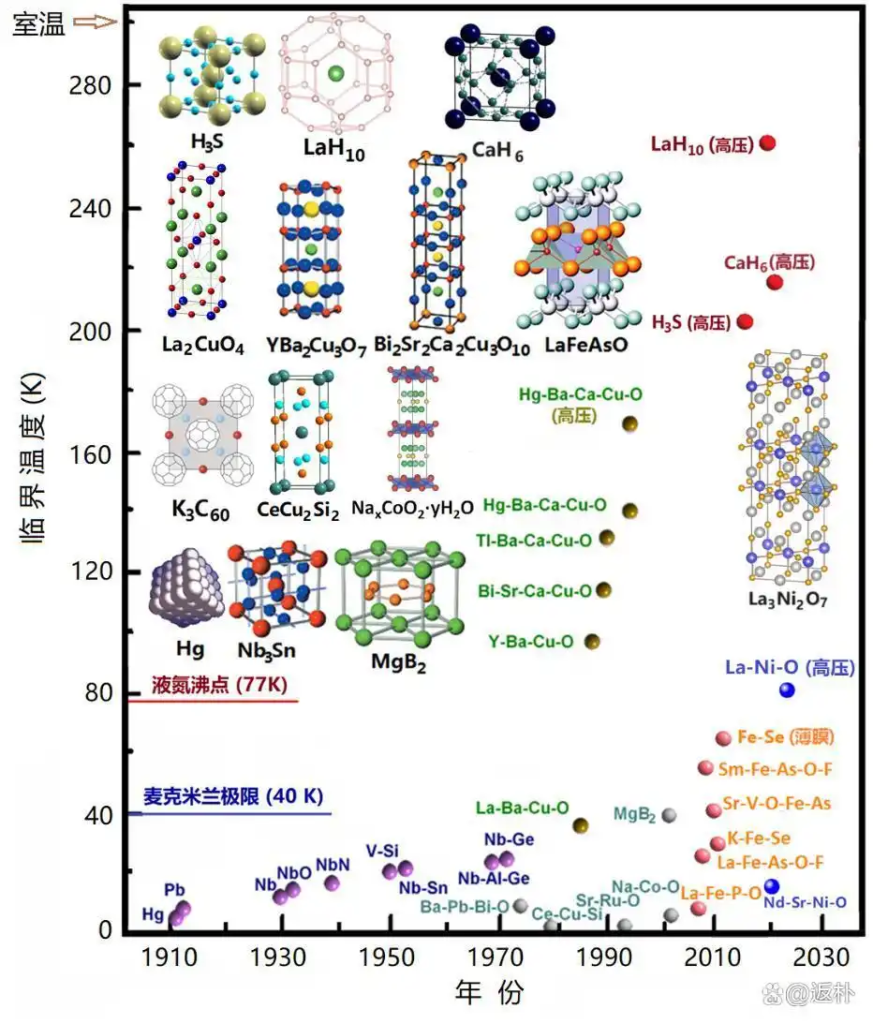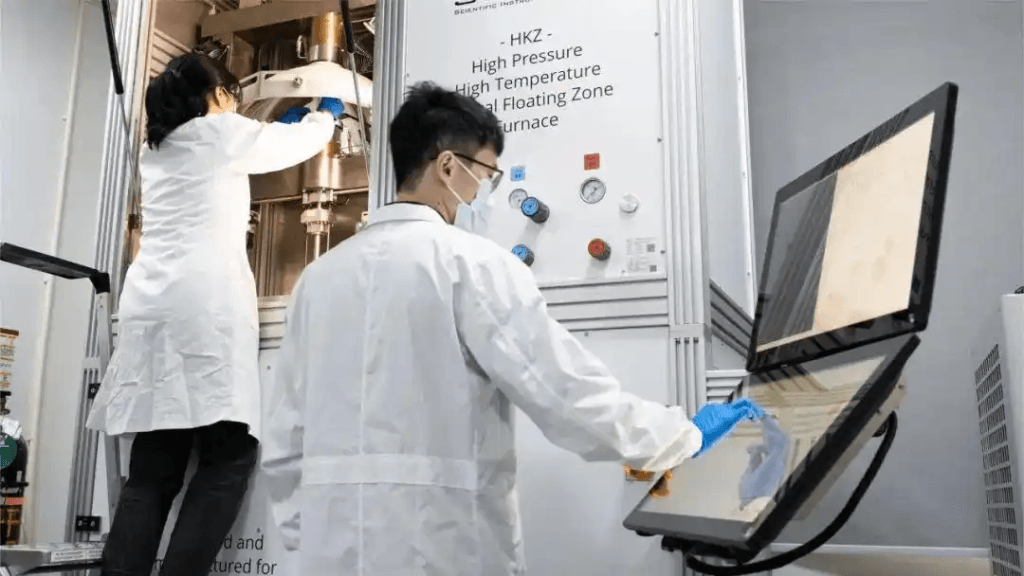On February 18, 2025, a groundbreaking achievement in the field of high-temperature superconductivity was announced by a joint research team led by Academician Xue Qikun, President of Southern University of Science and Technology (SUSTech), in collaboration with the Guangdong-Hong Kong-Macao Greater Bay Area Quantum Science Center and Tsinghua University. Their findings, published in the prestigious journal Nature, revealed that nickel-based materials[1] have become the third class of high-temperature superconducting materials to surpass the 40K “McMillan limit” at ambient pressure, following copper-based and iron-based materials. This monumental discovery marks a significant step forward in the quest to understand and harness high-temperature superconductivity. The research team successfully demonstrated high-temperature superconductivity in nickel oxide materials at ambient pressure, with a superconducting transition temperature[2] exceeding 40 Kelvin (K), equivalent to -233 degrees Celsius. They observed both “zero resistance” and “diamagnetism,” the two hallmark characteristics of superconductivity. This achievement provides a new pathway for addressing the scientific challenges surrounding the mechanism of high-temperature superconductivity[3]. Superconductivity, often likened to a “zero-energy-consumption sports car” on the electric power highway, allows electric current to flow without any energy loss. Since its discovery in 1911, the pursuit of higher-temperature superconducting materials has been a major focus of the international scientific community. The potential applications of superconductivity are vast, ranging from lossless power transmission to magnetic levitation trains and advanced quantum computing.
In recent years, nickel-based superconducting materials have emerged as a promising candidate in this field. While numerous studies worldwide have reported progress in nickel-based superconductivity, achieving high-temperature superconductivity at ambient pressure has remained a formidable challenge. The breakthrough by the Chinese research team represents a significant leap forward in overcoming this hurdle.
According to SUSTech, the research team, led by Academician Xue Qikun and Associate Professor Chen Zhuoyu, spent three years developing a novel technique called “strongly oxidizing atomic layer-by-layer epitaxy.” This technique enables the precise growth of atomic layers under conditions with oxidation capabilities tens of thousands of times stronger than traditional methods. By meticulously controlling the chemical composition, the team was able to construct complex, thermodynamically metastable oxide films with near-perfect crystalline quality. This process is akin to building with atomic-scale Lego blocks, allowing for the creation of materials with unprecedented precision.
Academician Xue Qikun described this achievement as a major advancement in oxide thin-film epitaxy technology. Not only does it provide a solution to the oxygen deficiency problem in various oxides, including wide-bandgap semiconductors, but it also opens new avenues for the artificial design and preparation of strongly correlated electronic systems, such as high-temperature superconductors.
The research team applied this technique to the development of nickel-based superconducting materials. Specifically, they arranged nickel and oxygen atoms with atomic precision on atomically smooth substrates to create ultrathin films just a few nanometers thick. In an extremely oxidizing environment, the team employed interface engineering to achieve what they termed “atomic riveting,” stabilizing atomic structures that would typically require extremely high pressure to maintain.
The team tested over a thousand samples before successfully achieving superconductivity at ambient pressure. Through precise electromagnetic transport measurements, they observed zero resistance and diamagnetism, confirming the presence of high-temperature superconductivity.
It is worth noting that nickel-based superconductivity research is a highly competitive frontier in the global scientific community. Almost simultaneously with the Chinese team’s announcement, researchers from Stanford University in the United States reported similar findings in a comparable material system. However, the Chinese team’s work stands out due to its exclusive use of domestically developed instruments and the unique strongly oxidizing thin-film growth technique they pioneered. This not only led to a higher crystalline quality in the films but also laid a solid foundation for China’s long-term independent development in the fields of superconductivity and quantum materials.
The implications of this breakthrough are profound. High-temperature superconductors have the potential to revolutionize numerous technologies, including energy transmission, magnetic resonance imaging (MRI), and quantum computing. By achieving superconductivity at higher temperatures and ambient pressure, the cost and complexity of cooling systems can be significantly reduced, making these technologies more accessible and practical.
The success of the Chinese research team also highlights the importance of sustained investment in fundamental research and the development of cutting-edge technologies. The ability to achieve such a breakthrough using entirely domestically developed equipment underscores China’s growing capabilities in scientific innovation and technological independence.
In conclusion, the discovery of high-temperature superconductivity in nickel oxides at ambient pressure by the Chinese research team represents a monumental achievement in the field of superconductivity. This breakthrough not only advances our understanding of high-temperature superconductivity but also paves the way for the development of new technologies that could transform industries and improve quality of life. As the global scientific community continues to explore the potential of nickel-based superconductors, China’s contributions will undoubtedly play a pivotal role in shaping the future of this exciting field.
Expanding on the Significance of the Breakthrough

The discovery of high-temperature superconductivity in nickel oxides at ambient pressure is a landmark achievement that has far-reaching implications for both fundamental science and practical applications. To fully appreciate the significance of this breakthrough, it is essential to delve deeper into the science of superconductivity, the challenges associated with high-temperature superconductors, and the potential applications of this technology.
Understanding Superconductivity
Superconductivity is a quantum mechanical phenomenon where certain materials can conduct electric current with zero resistance when cooled below a critical temperature. This means that electrical energy can be transmitted without any loss, a property that has the potential to revolutionize power grids, transportation, and electronic devices.
The phenomenon was first discovered in 1911 by Heike Kamerlingh Onnes, who observed that mercury exhibited zero electrical resistance at temperatures close to absolute zero (-273.15°C). Since then, scientists have been on a quest to find materials that exhibit superconductivity at higher temperatures, as this would reduce the need for expensive and complex cooling systems.
The McMillan Limit and High-Temperature Superconductors
In 1968, physicist William McMillan proposed a theoretical limit, known as the “McMillan limit,” which suggested that conventional superconductors could not exhibit superconductivity above approximately 40K (-233°C). This limit was based on the understanding of superconductivity at the time, which relied on the BCS theory (named after John Bardeen, Leon Cooper, and John Robert Schrieffer). The BCS theory explains superconductivity in terms of the formation of Cooper pairs—pairs of electrons that move through a lattice without resistance.
However, in 1986, the discovery of high-temperature superconductivity in copper-based materials (cuprates) by Georg Bednorz and K. Alex Müller shattered the McMillan limit. These materials exhibited superconductivity at temperatures as high as 138K (-135°C), well above the previously accepted limit. This discovery opened up new possibilities for superconductivity research and led to the identification of other high-temperature superconductors, including iron-based materials.
The Emergence of Nickel-Based Superconductors

Nickel-based superconductors are the latest addition to the family of high-temperature superconductors. Like copper and iron, nickel is a transition metal, and its electronic structure makes it a promising candidate for superconductivity. However, achieving superconductivity in nickel-based materials has proven to be more challenging than in copper- or iron-based materials.
One of the main challenges has been the need for high pressure to stabilize the superconducting phase in nickel-based materials. High-pressure environments are difficult to maintain and are not practical for most applications. Therefore, achieving superconductivity in nickel-based materials at ambient pressure has been a major goal for researchers in the field.
The Chinese Research Team’s Breakthrough

The Chinese research team’s success in achieving high-temperature superconductivity in nickel oxides at ambient pressure is a testament to their innovative approach and technical expertise. By developing the “strongly oxidizing atomic layer-by-layer epitaxy” technique, they were able to create high-quality nickel oxide films with precise atomic control. This technique allowed them to stabilize the superconducting phase without the need for high pressure, a significant achievement that has eluded researchers for years.
The team’s ability to observe both zero resistance and diamagnetism in their samples provides strong evidence for the presence of superconductivity. These observations are crucial for confirming the superconducting state, as they demonstrate the material’s ability to conduct electricity without resistance and expel magnetic fields—a phenomenon known as the Meissner effect.
Implications for Fundamental Science
The discovery of high-temperature superconductivity in nickel oxides at ambient pressure has important implications for our understanding of superconductivity. It challenges existing theories and provides new insights into the mechanisms that drive superconductivity in transition metal oxides. By studying these materials, scientists can gain a deeper understanding of the complex interactions between electrons, lattice vibrations, and magnetic fields that give rise to superconductivity.
This breakthrough also opens up new avenues for research into other strongly correlated electron systems. Strongly correlated materials, such as high-temperature superconductors, exhibit complex behaviors that are not well understood. By developing new techniques for synthesizing and studying these materials, researchers can uncover new phenomena and potentially discover new classes of superconductors.
Potential Applications
The practical applications of high-temperature superconductors are vast and transformative. One of the most promising applications is in the field of energy transmission. Superconducting power cables can transmit electricity with zero loss, significantly improving the efficiency of power grids and reducing energy waste. This could lead to lower energy costs and a reduction in greenhouse gas emissions.
Another potential application is in magnetic resonance imaging (MRI). Superconducting magnets are already used in MRI machines to generate strong magnetic fields, but they require expensive cooling systems to maintain the superconducting state. High-temperature superconductors could reduce the cost and complexity of these systems, making MRI technology more accessible.
Superconductors also have the potential to revolutionize transportation. Magnetic levitation (maglev) trains, which use superconducting magnets to levitate above the tracks, can achieve extremely high speeds with minimal friction. High-temperature superconductors could make maglev technology more practical and cost-effective, leading to faster and more efficient transportation systems.
In the field of quantum computing, superconductors are used to create qubits, the basic units of quantum information. High-temperature superconductors could enable the development of more stable and scalable quantum computers, which have the potential to solve complex problems that are currently intractable for classical computers.
China’s Role in the Global Scientific Community
The success of the Chinese research team in achieving high-temperature superconductivity in nickel oxides at ambient pressure is a testament to China’s growing capabilities in scientific research and technological innovation. By using entirely domestically developed instruments and techniques, the team has demonstrated China’s ability to compete at the highest levels of global science.
This achievement also highlights the importance of international collaboration in scientific research. While the Chinese team’s work was conducted independently, it builds on decades of research by scientists around the world. The global scientific community benefits from the free exchange of ideas and knowledge, and breakthroughs in one country can inspire and inform research in others.
Conclusion
The discovery of high-temperature superconductivity in nickel oxides at ambient pressure by the Chinese research team is a monumental achievement that has the potential to transform both fundamental science and practical technology. By overcoming the challenges associated with nickel-based superconductors, the team has opened up new possibilities for research and innovation in the field of superconductivity.
As the global scientific community continues to explore the potential of high-temperature superconductors, China’s contributions will play a crucial role in shaping the future of this exciting field. The implications of this breakthrough are far-reaching, with the potential to revolutionize energy transmission, transportation, medical imaging, and quantum computing. This achievement is a testament to the power of scientific research and the importance of investing in the pursuit of knowledge.



